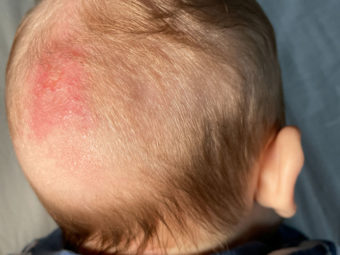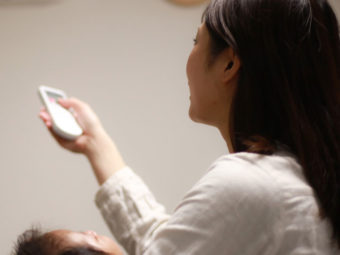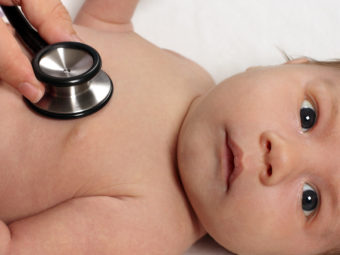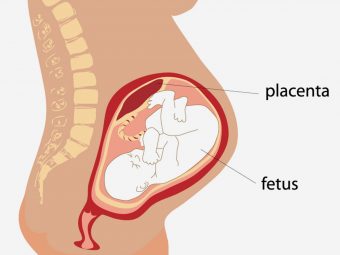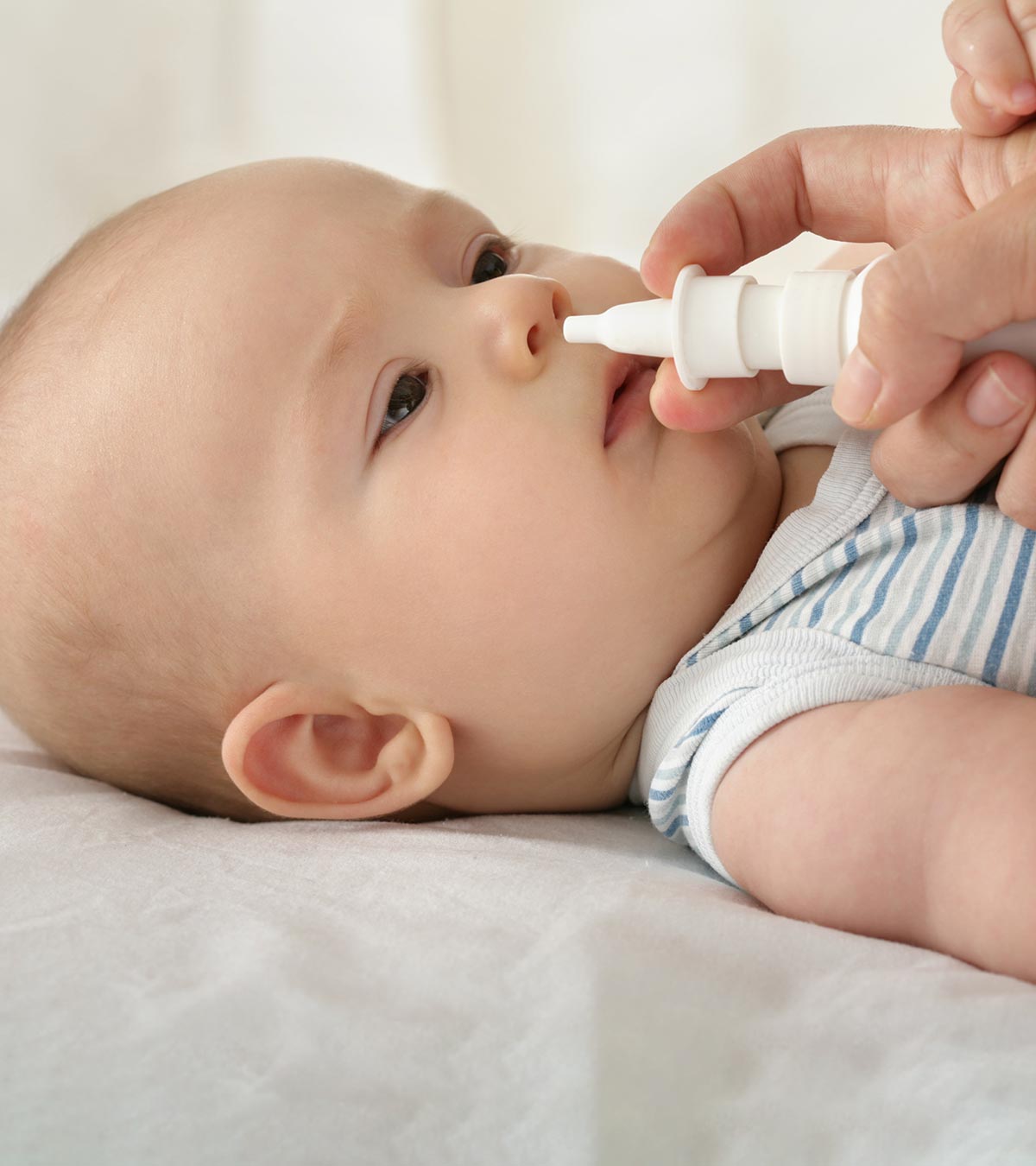
Image: iStock
Sinus infection in babies, flu, or common cold is mainly the common reason behind the stuffy nose and other similar symptoms, but they may also result from a non-allergic rhinitis (1). In these symptoms, the tissue lining of the nasal cavity and the sinus regions get swollen due to the blood vessels’ inflammation that occurs after the infection (2) (3). However, both sinusitis and the common cold are different from each other, and this difference can be pointed out by looking at the symptoms and age of the baby/child. In the case of the common cold, the symptoms usually resolve themselves within seven to ten days, whereas in the case of sinusitis, they might last for about 12 days or longer (4). Read this post to know more about the causes, signs, diagnosis, treatment, and prevention of sinus infection in infants.
What Is Sinus Infection?
Sinuses are small air spaces in the bones around the nose. Four sets of hollow spaces are located in the cheekbones, forehead, on the sides of the nose bridge, and behind nasal passages in front of the brain.
Sinuses in the cheekbones are called maxillary sinus, forehead – frontal sinus, behind nasal passages – ethmoid sinuses, and deep in the brain – sphenoid sinus.
The sinus cavities only develop with age – they are not yet present in the newborn: The maxillary sinus develops around three to five years, the frontal sinus closer to five years and the deeper located sphenoid sinus only in adolescence.
The infection attacks these air spaces in the bones, and sometimes they are swollen. In simple terms, sinusitis is an inflammation of the lining of the nose and sinuses, resulting in sinus pressure. The mucous membranesiXThe protective mucous secreting the inner lining of the organs and body cavities. that line the mouth and the nose also line the sinuses (5).
Sinusitis is an inflammation of the sinus due to a viral infection or a bacterial infection (6). Examining maxillary sinus aspirate samples from 31 pediatric acute maxillary sinusitis patients, a study conducted bacterial Polymerase Chain Reaction (PCR) to detect bacterial presence. The results demonstrated the existence of 39 bacteria, the most commonly detected bacterium being H influenzae, identified in 14 patients (36%). Additionally, S pneumoniae was detected in 10 patients (26%), M catarrhalis in 5 patients (13%), and C pneumoniae in 4 patients (10%).
The distribution of bacteria found in sinusitis patients
Source: Microbiology of Acute Maxillary Sinusitis in ChildrenDepending on the duration for which the symptoms stay, it can be categorized into the following types (7):
- Acute: Acute sinusitis is a condition where the symptoms last less than four weeks and improve with treatment.
- Sub-acute: The symptoms last four to eight weeks and do not subside with initial treatment.
- Chronic: This is a condition of repeated acute sinusitis or previous infections, which were inadequately treated. The symptoms last more than eight weeks.
- Recurrent: As the name suggests, recurrent is a condition where acute sinusitis repeats three or more times a year. You should consult an otolaryngologist (an ear, nose, and throat specialist) in this case.
So, if you suspect that your child is suffering from sinusitis, it is wise to consult a pediatrician promptly. This helps in determining the causes correctly and deciding on the appropriate treatment.
Symptoms Of Sinus Infection
Image: IStock
According to the American Academy of Pediatrics, cold symptoms such as nasal discharge and a cough that lasts more than ten days without any improvement, indicate a sinus infection (8).
Check for the following sinus infection symptoms in children:
- Nasal congestion or cold that lasts for more than ten to 14 days.
- Green-yellow discharge from the nose for more than four days.
- A bad bout of coughing in the daytime that becomes worse at night.
- Swelling around nose and eyes.
- Dark circles around the eyes.
- Irritability
- Post-nasal drip seen as a cough, sore throat, vomiting, nausea, and bad breath.
- Low-grade fever for at least four days in a row.
Note: A low-grade fever is a body temperature above 100.4°F or 38°C and below 103°F or 39.4°C.
In rare cases, a bacterial sinus infection could spread to the central nervous system (CNS) or the eye, showing symptoms such as:
- Increasing irritability
- Persistent vomiting
- Swelling and/or redness around the eyes
- Sensitivity to light
Keep a check on your child’s symptoms and do not delay in consulting a pediatrician. In case your child has been suffering from chronic sinusitis, immediate medical intervention is warranted. Chronic sinusitis can significantly impact the quality of life.
Causes For Sinus Infection In Babies
Sinus infection is generally seen after a cold, an allergic inflammation, or upper respiratory infection (URI). However, Mayo Clinic’s Allergic Diseases Research Laboratory researcher, Dr. David Sherris, says that the cause of chronic sinusitis has not been known so far.
“Our studies indicate that fungus is likely the cause of nearly all of these problems. And it is not an allergic reaction, but an immune reaction,” Dr. Sherries adds.
According to her team, the primary cause of chronic sinusitis is the reaction of the immune system to fungi. The researchers studied 210 patients and found 40 different kinds of fungi in their mucus (9).
- The URI causes nasal passage inflammation that blocks the opening of the paranasal sinuses, eventually leading to an infection. Viral sinusitis accompanies cold. However, sinusitis can also happen due to bacterial infections. The most common bacteria that cause acute sinusitis are (4):
- Streptococcus pneumonia
- Haemophilus influenzae
- Moraxella catarrhalis
- Allergies also lead to sinusitis as they increase mucus production and cause the nasal tissue to swell (10). Allergic sinusitis accompanies allergies, such as hay fever.
- Other possible conditions that could block the sinuses are:
Image: Shutterstock
- Abnormalities in the nose structure
- Cleft palateiXA congenital condition where there is a split or opening in the roof of the mouth due to incomplete joining of the tissues.
- Diving and swimming
- Enlarged adenoids
- Gastroesophageal reflux disease (GERD)
- Tooth infections
- Trauma to the nose
- Secondhand smoking
- Foreign objects stuck in the nose
Pediatric sinusitis cannot be diagnosed easily at home as the symptoms are general and often overlap with the symptoms of common cold and allergy. Thus, to get the right diagnosis, prompt pediatric consultation is necessary.
How To Diagnose Sinusitis In Babies?
Many parents, and in some cases, even the doctor may misdiagnose a sinus infection. A runny nose with green mucus might not be a sign of sinusitis. It could be a common cold, which does not need specific treatment.
An ENT specialist will thoroughly examine the nose, throat, and ears of the baby and ask you about the history of such attacks, to diagnose the medical condition. Additional tests done to diagnose sinusitis are mentioned next (11).
- A computed tomographic (CT) scan helps in determining the development of the child’s sinuses and blockage if any. The diagnostic imaging procedure combines X-ray and computer technology to produce axial or vertical images of the body.
- MRI scans use invisible electromagnetic energy beams to produce images of internal tissues, bones, and organs.
- Cultures from the sinuses are collected and grown in the lab conditions to diagnose the infection.
Once the diagnosis is made, your doctor will prescribe the treatment accordingly. Most often, the treatment would be simple.
How Will The Doctor Treat Sinusitis?
After the doctor confirms the sinusitis infection in your baby, they may suggest the following treatments (12).
- Nasal sprays: Saline nasal sprays may provide temporary relief from stuffiness. Saltwater or nasal drops help in thinning secretions and improving the functioning of the mucous membrane. Saline drops can be made at home. Add one-fourth teaspoon salt to an eight-ounce cup of warm water and mix well. Flush each nostril with the saline solution at least four times a day.
If your baby’s nose still seems to be stuffed and is causing discomfort, other alternatives like nasal aspirator or nasal bulb syringe to clean the baby’s nose could also be tried under pediatric consultation.
- Antibiotic treatment: If your child has bacterial sinusitis, you may need to give antibiotics for at least ten days, and for a maximum of 21 days. For a childbaby with acute sinusitis, symptoms should improve within the initial days of treatment. Complete the antibiotic treatment even if the child’s condition improves.
Image: IStock
Note: Do not give antihistamines and over-the-counter decongestants to babies less than two years old (13).
- Surgical treatment: The baby may have to undergo surgery if sinusitis symptoms persist despite the administration of pediatric medicines.
Endoscopic sinus surgery is an option for severe sinus infection. It is a functional surgery that involves the doctor opening the natural drainage pathway of the child’s sinuses to make it wider. Opening up the sinuses allows air circulation that eventually results in the reduced number of sinus infections (14).
In some other severe cases, surgical treatment may involve the removal of adenoid tissueiXLymphatic tissues between the back of the nose and throat that help fight infections. from behind the nose. The adenoid tissue may not directly block the sinuses, but its infection, called adenoiditis, causes symptoms similar to sinusitis (15).
Additionally, the doctor may also suggest steam therapy or steam inhalation and nasal irrigation with water as home treatments. However, since these require proper techniques, only administer these techniques after discussing the safety and guidelines with the doctor.
How To Prevent The Risk Of Sinusitis In Children?
Image: IStock
For sinusitis, prevention is not easy, yet a few steps could help keep your baby safe (16).
- Keep your child away from known allergens.
- Minimize their exposure to pollutants, such as tobacco smoke.
- Reduce the baby’s daycare time.
- Treat the stomach acid reflux disease if found in your baby.
- Keep the atmosphere in your baby’s room moist. It stops cold from worsening.
- Get the best treatment for allergies, if any.
- Keep your home clean and clear of dust and smoke.
- Use a humidifier to maintain the humidity of the room at 45% to 50%.
- Allow fresh air to enter the house.
- Maintain hygiene to help prevent the spread of the virus.
 Quick tip
Quick tipNext, we address a few commonly asked questions about sinusitis in babies.
Frequently Asked Questions
1. Is a sinus infection contagious in babies?
The sinusitis itself is not contagious, but the organism causing the infection can spread to others.
2. Can sinus infections lead to serious health issues or complications?
Serious complications are rare. However, an untreated sinus infection can spread to other areas in the skull.
- The sinuses around the eye and the brain are separated by just a thin membrane. So, if the infection spreads to the passages around the eye, it could also penetrate through the membrane of the brain, causing meningitisiXAn inflammation of the membrane surrounding the brain and spinal cord due to an infection, injury, specific medicines, or cancer. .
- Infection in the bones is called osteomyelitis.
- Infection in the tissues surrounding the eyes is called orbital cellulitis.
3. At what age can babies get sinus infections?
There is no specific age when sinus infections may become more prevalent in babies. But, studies highlight that before three years, about 10% of children may have experienced an episode of acute bacterial sinus infection at least once (17).
Sinus infection is troublesome for children and parents. It is important to distinguish between a simple upper respiratory tract infection and the more invasive sinusitis. Your baby may become restless, irritable, and cry incessantly due to the symptoms, including nasal congestion, cough, mild fever, and swollen eyes and nose. Since babies are prone to such infections, you may focus on preventing the risk of more invasive infection by following a few tips such as maintaining proper hygiene and cleanliness at home, avoiding allergen exposure, allowing fresh airflow in the house, etc. However, if your child’s sinus infection lasts for more than 10-15 days, it is best to contact a pediatrician to facilitate prompt medical care.
Infographic: How Do You Identify Common Colds, Sinus Infections, Or Allergies In Babies?
Common colds, sinus infections, and allergies have overlapping signs and symptoms, and it can often be confusing to differentiate the exact cause. Seasonal incidence for these conditions can also be similar. Go through the infographic to differentiate what is causing respiratory symptoms in your baby. Illustration: Momjunction Design Team
Key Pointers
- Nasal congestion, green-yellow nasal discharge, persistent cough, and swollen eyes that last for more than 12 days may be associated with sinusitis.
- Sinusitis is an inflammation of the sinus cavity possibly caused by allergies or microbial infections.
- Diagnosis of sinusitis is made by a medical professional with the help of scans or culture tests.
- Primary courses of treatment in children include nasal sprays and antibiotics or surgery in severe cases.
- Avoiding allergen exposure, treating underlying allergies or illnesses, and maintaining proper hygiene may help prevent sinus infections.
Sinus infections in babies can be scary, but there are treatments available. Learn how to treat them with this helpful video.
References
1. Stuffy or runny nose – adult; U.S National Library of Medicine
2. Common Cold; University of Rochester
3. Sinusitis; U.S National Library of Medicine
4. Sinusitis in Children; Stanford Children’s Health
5. Sinus Infection; American College of Allergy, Asthma and Immunology
6. The Difference Between Sinusitis and a Cold; Healthy Children; American Academy of Pediatrics
7. Sinusitis; Medline Plus
8. Pediatric Sinusitis; American Academy of Otolaryngology–Head and Neck Surgery Foundation
9. Mayo Clinic Study Implicates Fungus As Cause Of Chronic Sinusitis; Science Daily
10. Allergic Sinusitis; Cedars Sinai
11. Sinusitis; NHS
12. What to do about sinusitis; Harvard Medical School
13. Use Caution When Giving Cough and Cold Products to Kids; USFDA
14. Functional Endoscopic Sinus Surgery (FESS); Children’s Hospital of Philadelphia
15. Adenoid removal; U.S National Library of Medicine
16. Sinusitis in Children; University of Rochester
17. Alexander KC Leung et al., (2020); Acute bacterial sinusitis in children: an updated review; U.S National Library of Medicine.







 Be watchful
Be watchful Quick fact
Quick fact



